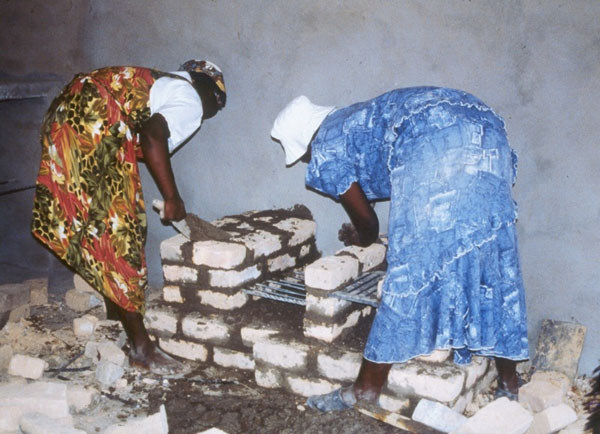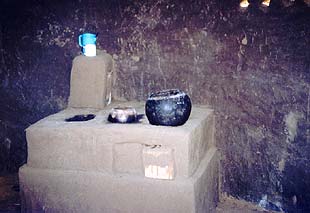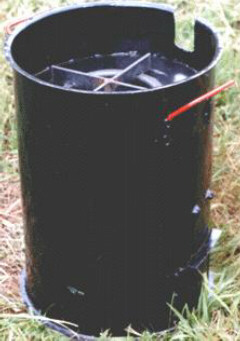
 Mwenezi Zimbabwe
Mwenezi Zimbabwe

Wood Burning Stoves of Zimbabwe
L. Mika, Mrs. J. Tawha SIRDC, Harare
Lmika@sirdc.ac.zw
ProBEC Newsletter February 2001
The idea behind this article is to highlight stoves that have been used and are currently being used
in Zimbabwe. This is dedicated to various organisations and individuals that have
contributed to improving the kitchen environment and conserve energy. The stoves presented here
are mainly biomass burning stoves.
It is important to re-look at past efforts and reconcile with new ideas to achieve meaningful
results in stove technologies. This is not a conclusive effort but provokes inputs from readers
to contribute further information, corrections or additions on stoves highlighted below or those not
included.
The Three Stone Stove
The most common traditional stove, it is affordable and easy to make. Built with three
movable support stones and a grate (optional), this stove is easily adjustable to hold any size of a
pot. It also provides warmth and with improvements like wind shielding, the stove
efficiency can be greatly improved. However it poses security risk to the user and children.
The Metal Grate Stove
Pseudo-named the Mbare Stove (a suburb in Harare, probably its place of origin) or metal
grate. It was introduced in the early eighties and has remained to date Zimbabwe’s successful
commercial wood stove. A modification of the three stone fire, the stove has enhanced pot
security. It is multi-pot and can be made to any height to suit the user needs. Affordability,
portability, durability and low maintenance are among the features that have favoured the high
adoption of the stove.
Hollow Core Cookers
It was developed by a private company Hollow Core Pvt, for Triangle Pvt Limited to address
energy needs of the workers at the estate. The stove is a metal cylinder with a solid steel core
and a compactor for packing fuel. The fuels used were wood shavings, cotton waste and baggasse.
The stove was not successful. It was reported that it was difficult to light and even worse with wet
fuels. There were problems with waste storage in the small house provided by the employers.
Cotton waste produced irritating smoke leading directly to ill health (greater incidence of flue and
chest pains). The high intensity heat damaged pots and flying ash caused small holes in clothes.
The food quality was poor, as taste was affected,children had to be removed from the vicinity for
fear of burns.
Tsotso (Small sticks) Stove
Tsotso is vernacular word for small sticks. The stove is a small portable metal single or multi-pot
wood burning stove. It is constructed from metal sheet with vermiculite insulation enclosed
between the inner and outer cylindrical walls. The combustion system is extremely efficient and the
stove will effectively burn small pieces of wood, and other waste. Originally developed by the
Development Technology Centre (DTC) based at the University of Zimbabwe. Tsotso stove is a
commercial product produced by a local engineering company.
Among the desirable features of the stove is fast cooking, less smoke, and fuel economy. However
it has been criticised for damaging metal pots at the centre. Traditionally people want to see the
fire to enable to control it. Unfortunately the enclosure can not allow for that.
Chingwa Stove
Chingwa meaning bread, this high-mass stove is made of bricks with mud. It is fitted with a metal
grate, a pot hole and a hot plate. An oven can be incorporated for bread baking. It has a chimney
that takes the smoke out of the room thereby improving the kitchen environment. This stove
was widely disseminated by government through the Department of Energy and NGO’s like
Zimbabwe Women’s Bureau, Africa 2000 and churches.
“Yugen” Mud Stove
Named after the trainer, this stove was introduced in the Plumtree district by AVOCA training centre.
The stove is difficult to construct and takes time. Built of wire mesh reinforced mud it has a small
outlet for ash removal, the stove been constructed mainly outside the kitchen. The ash outlet hole
later became a habitat for insects and snakes. Potential users could not afford the wire mesh.
Jengeta Huni/Quedidubo Stove
Two-pot mud stove is currently being promoted by the ProBEC project in Hurungwe and in Plumtree.
The pot rest allows for the removal of smoke thereby improving the kitchen environment. The
stove uses small pieces of wood and saves fuel.
For further inputs to this article, please contact:
Mr. L. Mika or Mrs. J. Tawha at (SIRDC, P O Box
6640 Harare) or lmika(a)sirdc.ac.zw.
Note: Photos by Miles for reference, not provided with article.
 |
 Mwenezi Zimbabwe Mwenezi Zimbabwe |
 |
 |
|
Tsotso (Namibia) Quedidubo Stove
|
Tsotso (Zimbabwe
|
DTC ZIMBABWE (Tsotso Stove)
Development Technology Centre
Address: University of Zimbabwe Tel: +263 4 334257
P.O. Box MP 167 Fax: +263 4 333407
Mount Pleasant, Harare E-mail: rukuni@agric.uz.ac.zw
In-Charge: Mr. Tungamirai Rukuni, Director
SIRDC ZIMBABWE
Scientific & Industrial Research & Development Centre
Address: P.O. Box 6640 Tel: +263 4 860321
Harare Fax: +263 4 860348
E-mail: pbhebhe@sirdc.ac.zw
Home page: www.sirdc.ac.zw